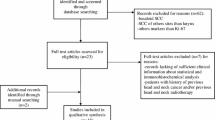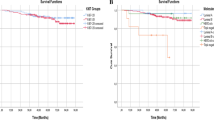Abstract
The aim of this study was to determine the prognostic value of Ki-67 immunostaining in laryngeal squamous cell carcinomas. Ki-67 labeling was quantified in 63 laryngeal squamous cell carcinomas by counting at least 1,000 tumor cells in the most immunoreactive area in each sample, and the Ki-67 labeling index was calculated as a percentage. The antigen expression was compared with clinical factors, histopathological grading and prognosis. The Ki-67 mean proliferation index for all patients was 25.44% ( range, 2–75%). A significant correlation was found between Ki-67 mean proliferation index and patient age (P<0.05), T-stage (P<0.05), nodal metastasis (P=0.001) and recurrence (P<0.001). There was no significant association between the Ki-67 mean proliferation index and tumor site or histologic grade. A univariate analysis showed that the Ki-67 labeling index >21% (P<0.001), T-stage (P<0.001) and nodal metastasis (P=0.001) are determinants of recurrence. In the multivariate analysis, the Ki-67 labeling index >21% (P<0.001), T-stage (P<0.001) and nodal metastasis (P<0.05) were independent predictors of recurrence. Kaplan-Meier plots of survival in patients with Ki-67 values above and below the median (21%) of the general study population showed that a high Ki-67 labeling index correlated with a shorter disease-free survival (P<0.0001). The analysis of the Ki-67 labeling index at the time of initial surgery may be a powerful prognostic marker for patients with laryngeal squamous cell carcinoma and may be useful for selecting subgroups of patients who should be treated with more aggressive therapies.


Similar content being viewed by others
References
Aaltomaa S, Lipponen P, Ala-Opas M, Eskelinen M, Syrjanen K (1997) Prognostic value of Ki-67 expression in renal cell carcinomas. Eur Urol 31:350–355
Deshmukh P, Ramsey L, Garewal HS (1990) Ki-67 labeling index is a more reliable measure of solid tumor proliferative activity than tritiated thymidine labeling. Am J Clin Pathol 94:192–195
Gallo O, Libonati GA, Gallina E, Fini-Storchi O, Giannini A, Urso C, Bondi R (1991) Langerhans cells related to prognosis in patients with laryngeal carcinoma. Arch Otolaryngol Head Neck Surg 117:1007–1010
Golusinski W, Olofsson J, Szmeja Z, Majewski P (1996) P53, PCNA and Ki-67 in laryngeal cancer. Pol J Pathol 47:175–182
Grzanka A, Sujkowska R, Janiak A, Adamska M (2000) Immunogold labelling of PCNA and Ki-67 antigen at the ultrastructural level in laryngeal squamous cell carcinoma and its correlation with lymph node metastasis and histological grade. Acta Histochem 102:139–149
Hagedorn HG, Tubel J, Wiest I, Nerlich AG (1998) In situ apoptotic and proliferation index in laryngeal squamous cell carcinomas. Anal Cell Pathol 16:177–184
Holte H, de Lange Davies C, Beiske K, Stokke T, Marton PF, Smeland EB, Hoie J, Kvaloy S (1989) Ki-67 and 4F2 antigen expression as well as DNA synthesis predict survival at relapse/tumor progression in low-grade B-cell lymphoma. Int J Cancer 44:975–980
Kamel OW, Franklin WA, Ringus JC, Meyer JS (1989) Thymidin labeling index and Ki-67 growth fraction in lesions of the breast. Am J Pathol 134:107–113
Lazaris AC, Rigopoulou A, Tseleni-Balafouta S, Kavantzas N, Thimara I, Zorzos HS, Eutychiadis CA, Petraki K, Kandiloros D, Davaris P (2002) Immunodetection and clinico-pathological correlates of two tumour growth regulators in laryngeal carcinoma. Histol Histopathol 17:131–138
Pera E, Moreno A, Galindo L (1986) Prognostic factors in laryngeal carcinoma: A multifactorial study of 416 cases. Cancer 58:928–934
Perez Carro Rios A, Garcia Caballero T, Lozano Ramirez A, Arias Santos MD, Soto Varela A, Forteza Vila J, Labella Caballero T (2000) The relationship between survival and cell proliferation index in squamous cell carcinoma of larynx. Rev Laryngol Otol Rhinol (Bord) 121:121–125
Pradier R, Gonzalez A, Matos E, Loria D, Adan R, Saco P, Califano L (1993) Prognostic factors in laryngeal carcinoma: Experience in 296 male patients. Cancer 71:2472–2476
Pulkkinen JO, Penttinen M, Jalkanen M, Klemi P, Grenman R (1997) Syndecan-1: a new prognostic marker in laryngeal cancer. Acta Otolaryngol 117:312–315
Sittel C, Eckel HE, Damm M, von Pritzbuer E, Kvasnicka HM (2000) Ki-67 (MIB-1), p53, and Lewis-X (LeuM1) as prognostic factors of recurrence in T1 and T2 laryngeal carcinoma. Laryngoscope 110:1012–1017
Spafford MF, Koeppe J, Pan Z, Archer PG, Meyers AD, Franklin WA (1996) Correlation of tumor markers p53, bcl-2, CD34, Cd44H, CD44v6, and Ki-67 with survival and metastasis in laryngeal squamous cell carcinoma. Arch Otolaryngol Head Neck Surg 122:627–632
Taxy JB (1996) Upper respiratory tract. In: Damjanov I, Linder J (eds) Anderson’s pathology, 10th edn. Mosby, St. Louis, p 1463
Tungekar MF, Gatter KC, Dunnill MS, Masan DY (1991) Ki-67 immunostaining and survival in operable lung cancer. Histopathology 19:545–550
Twentyman RR (1988) Radiation response of tumours: Experimental. In: Bleehen NM (ed). Radiobiology in radiotherapy. Springer, Heidelberg Berlin New York, pp 9–15
Wintzer HO, Zipfel I, Schulte-Mönting J, Hellerich U, von Kleist S (1991) Ki-67 immunostaining of human breast tumors and its relationship to prognosis. Cancer 67:421–428
Youssef EM, Matsuda T, Takada N, Osugi H, Higashino M, Kinoshita H, Watanabe T, Katsura Y, Wanibushi H, Fukushima S (1995) Prognostic significance of the MIB-1 proliferation index for patients with squamous cell carcinoma of the esophagus. Cancer 76:358–366
Author information
Authors and Affiliations
Corresponding author
Rights and permissions
About this article
Cite this article
Acikalin, M.F., Öner, Ü., Tel, N. et al. Prognostic significance of Ki-67 expression for patients with laryngeal squamous cell carcinoma primarily treated by total laryngectomy. Eur Arch Otorhinolaryngol 261, 376–380 (2004). https://doi.org/10.1007/s00405-003-0699-3
Received:
Accepted:
Published:
Issue Date:
DOI: https://doi.org/10.1007/s00405-003-0699-3




